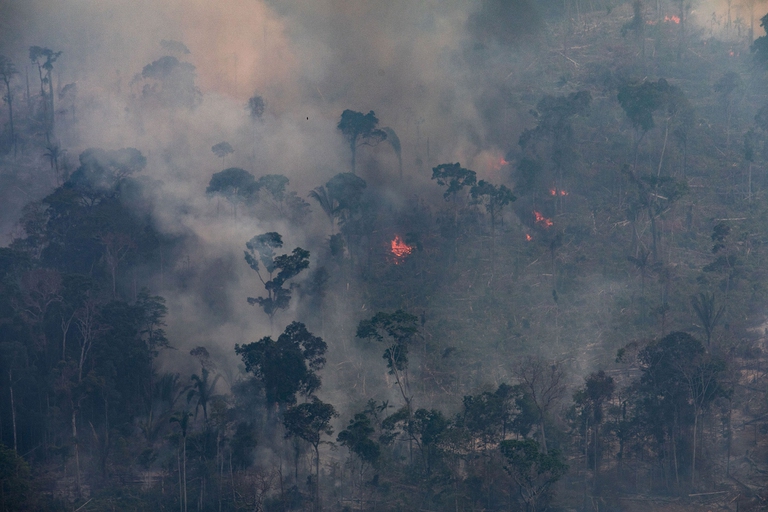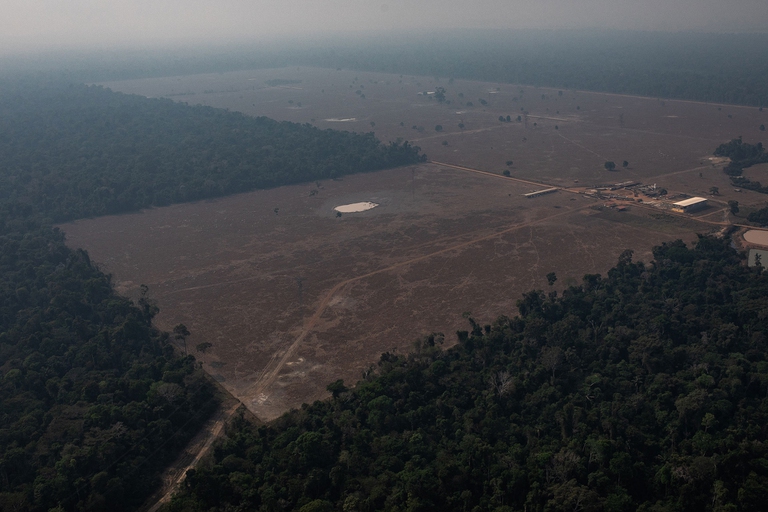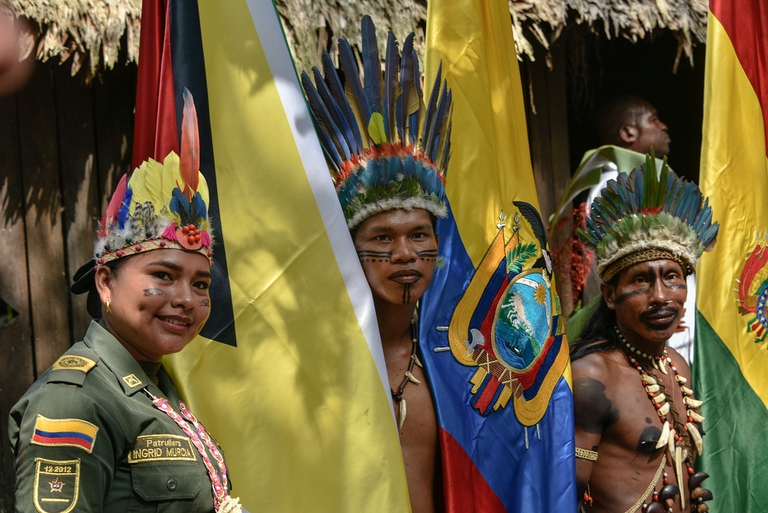
The Copernicus service has released data for the first eleven months of 2025: global warming is set to come close to last year’s record.
It may be true that some parts of the Amazon rainforest are slowly being turned into a savannah, but it’s crucial not to throw in the towel.
In the war against climate change, rather than fighting our enemies, we’re attacking our most important allies: the oceans, and the Amazon rainforest. The former absorb a huge amount of the Earth’s excess heat, while the latter produces rain and oxygen while absorbing massive amounts of carbon dioxide. However, we’re doing irreparable damage to these ecosystems, even though we all know that organisms that aren’t healthy are also unable to function properly.
This is an emergency. It’s not a joke.
This is what’s happening to the Amazon rainforest: its eastern regions, and especially parts in the southeast, have started to emit more CO2 than oxygen.
This troubling fact was revealed in a study published in the journal Nature by an international group of scientists, many of whom from Brazil, who examined four sites in the period between 2010 and 2018. The researchers are certain that the higher CO2 emissions are due to the fact that, over the past forty years, eastern Amazonia has been subject to an increased rate of deforestation, as well as higher temperatures combined with more frequent periods of drought, especially in the dry season.
“When the forest is degraded and suffers the impact of deforestation, the trees actually reduce their net CO2 storage capacity. They become less efficient in absorbing CO2 simply because they’re weaker, because they die sooner,” explains Isabella Pratesi, Director of Conservation at WWF Italy. “What upsets the balance most of all, however, are the emissions from wildfires. We know that when forests go up in flames, they emit large quantities of carbon monoxide and dioxide”.
Alongside the climate crisis and deforestation, which has been incentivised in Brazil since Jair Bolsonaro was elected, clearing space for agribusiness and mining, forest degradation is putting great stress on the Amazon rainforest. Another study published in Nature Climate Change highlighted the importance of AGB (aboveground biomass), which is all the biomass contained in both woody and grassy vegetation above the soil and includes stems, logs, branches, bark, seeds, and leaves. This collection of organic matter is a “carbon pool” – a component of the ecosystem that can absorb or release carbon dioxide – that we can all see with our own eyes and that risks not functioning ideally if there are any changes made to it.
It’s as if the great tropical rainforests, the Amazon and the Congo basin, are two ventricles in the same heart, alternately pumping.
When an ecosystem is degraded, these precious elements are lost. But there’s more. “We can talk about forest degradation when human activities enter the forest and gradually start removing biodiversity,” Pratesi explains. “The forest isn’t just made up of trees. It’s an incredibly rich system in which animals also play an extraordinary role. Therefore, a forest that starts losing its animals forfeits a vital factor in its regeneration. Thus, it’s gradually destined to degrade, becoming more prone to wildfires and emitting more CO2”.
As we mentioned at the start, we can’t let ourselves see the glass half-empty. Scientists predict that the rainforest may reach its tipping point by 2025. We still have a window, small as it may be. “We must protect those parts of the Amazon rainforest that still haven’t reached their tipping point,” says Leila Salazar-López, Executive Director of Amazon Watch. “The best way to do this is to ensure that indigenous rights are respected. What we need to do is protect 80 per cent of Amazonia by 2025”. Precisely because the time we have is so short, it’s time to act now and quickly, giving ourselves strict goals: zero deforestation, zero emissions. Which is different from net-zero emissions.
Continuing to extract oil and other fossil fuels is not sustainable. We need to transition to green energy and economic models. Amazon Watch places itself both in support of indigenous peoples and as an accuser of those responsible for deforestation and mining activities, which include governments, corporations, and banks. “Blackrock, the world’s largest investment company, is one of the primary funders of the exploitation of the Amazon and is at the centre of a campaign that we have called Blackrock’s Big Problem. They’re funding the climate crisis. We’re pushing them to change their policies”.
We have to restore ecosystems, reforest, and invest in solutions offered by indigenous communities, in their conservation projects. They’ve proven that they’re able to protect their lands. We need to put in place a model of development that is in harmony with the forest.
When you’re losing blood, you immediately think about stopping the bleeding. This is what we need to do.
The European Union is pushing for a law to put a stop to the importing of deforestation, and we need to ensure all countries support it. A large part of the destruction of forests, not only in Amazonia, is due to our patterns of consumption. In most Western countries we import enormous quantities of deforestation because we consume the food products that cause it.
“If we want to choose an action that, above all, can help protect forests, we need to stop consuming meat, especially meat that comes from intensive farms,” states Isabella Pratesi. “Meat from intensive farming requires enormous amounts of soy. And the soy that is imported to Europe comes from intensive farms in South America”.
What’s happening to the Amazon rainforest, wildfires in California and Sardinia, flooding in Germany, the Netherlands, China, India, and Nigeria, all prove to us that we’re all united in the struggle against climate change. We’re citizens of the world, and we’re universally affected by major crises – like the climate crisis and the pandemic. We all suffer their consequences, in one way or another.
This is another reason why, in the words of Salazar-López, the first thing we can do is to let indigenous people know that we’re on their side. “Two years ago we organised a global action day for the Amazon rainforest: students, activists, municipal organisations, NGOs all took part from places across the world. This year, in early September, we have an entire week planned. You can take part, anywhere you are. Another good thing to do is to take part in youth-organised climate strikes”.
We still have time, but there’s not much left. Let’s not waste it. We have data from scientists and solutions from indigenous people. It’s time to connect the dots.
Siamo anche su WhatsApp. Segui il canale ufficiale LifeGate per restare aggiornata, aggiornato sulle ultime notizie e sulle nostre attività.
![]()
Quest'opera è distribuita con Licenza Creative Commons Attribuzione - Non commerciale - Non opere derivate 4.0 Internazionale.
The Copernicus service has released data for the first eleven months of 2025: global warming is set to come close to last year’s record.
The European Council and Parliament have reached an agreement on the European Commission’s proposal to deregulate new GMOs. But farming, organic agriculture, and environmental organizations are calling for it to be stopped.
Several hundreds of women in India have rejuvenated vast stretch of forest land through a unique method of guarding the forest.
The solution developed by the Italian startup Agri-E enables on-site bioethanol production, promoting energy self-sufficiency for farms.
South African court dismisses a major lawsuit by 140,000 Zambian women and children against Anglo American for Kabwe lead poisoning. A setback for affected communities enduring the lasting impact of lead contamination.
Controversial African land deals by Blue Carbon face skepticism regarding their environmental impact and doubts about the company’s track record, raising concerns about potential divergence from authentic environmental initiatives.
Majuli, the world’s largest river island in Assam State of India is quickly disappearing into the Brahmaputra river due to soil erosion.
Food imported into the EU aren’t subject to the same production standards as European food. The introduction of mirror clauses would ensure reciprocity while also encouraging the agroecological transition.
Sikkim is a hilly State in north-east India. Surrounded by villages that attracts outsiders thanks to its soothing calmness and natural beauty.










